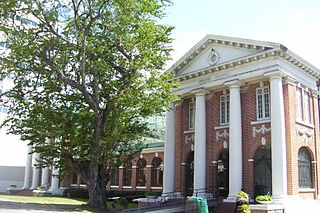
The Puerto Rico Museum of Contemporary Art, often abbreviated to MAC, is a contemporary art museum in Santurce, Puerto Rico.

Casa de Piedra, also known as Residencia Amparo Roldán, in Aguadilla, Puerto Rico, is a Spanish Colonial-style home that was erected in 1875. It is the only surviving residence of its era in Aguadilla; most similar ones were damaged in the 1918 San Fermín earthquake and eventually demolished.
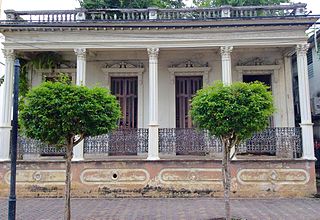
The López Residence is a historic house in Aguadilla, Puerto Rico. Built in 1914, this one-story, Neoclassical structure is architecturally significant as a typical urban residence for a well-to-do Puerto Rican family in the early 20th century, and as one of the most important remaining works by architect Manuel Gómez Tejera. Notable architectural elements of the house include its five slender, octagonal Corinthian columns, recessed ceiling panels on the balcony, ornate cast-iron balcony ornamentation, native ceramic tile floors, rooftop balcony, four louvered wooden doors with scrollwork frames facing the street, and filigreed interior arches supported by turned and octagonal columns. It faces the 1925 District Courthouse across Progreso Street, forming a historic Neoclassical set.

Church San José of Aibonito, on the town plaza of Aibonito, Puerto Rico, was built over the ten-year period from 1887–1897. It was listed on the U.S. National Register of Historic Places in 1984, and on the Puerto Rico Register of Historic Sites and Zones in 2000.
The Lassise–Schettini House, also known as La Quinta, is a historic house in Sabana Grande, Puerto Rico. It was designed by architect Luis Perocier and built in 1924 for Dr. Enrique Lassise, a physician and "remembered good-samaritan" of the town of Sabana Grande and his wife Matilde Schettini, a schoolteacher.

Iglesia de San Carlos Borromeo is a historic church built in 1783, located on the main plaza of Aguadilla, Puerto Rico. It was listed on the U.S. National Register of Historic Places in 1984, and on the Puerto Rico Register of Historic Sites and Zones in 2000.

The Iglesia de San Juan Bautista in Maricao, Puerto Rico is a church built during 1890-c.1898. It was listed on the National Register of Historic Places in 1984, and on the Puerto Rico Register of Historic Sites and Zones in 2000.

Edificio Oliver in Arecibo, Puerto Rico was built in 1914. The building houses government offices for the municipality of Arecibo.

Casa de España is the headquarters of a private social organization whose members are those of Spanish descent in San Juan, Puerto Rico on Avenida de La Constitución in Old San Juan.
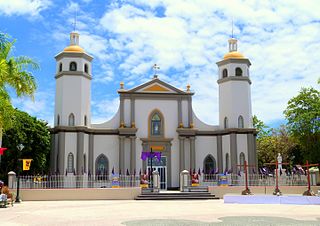
The Iglesia San Ramón Nonato, in some sources also referred to as Iglesia San Juan Bautista y San Ramón Nonato, is a Roman Catholic parish church in the town plaza of Juana Díaz, Puerto Rico.

The Iglesia San Sebastián Mártir in the plaza in San Sebastián, Puerto Rico was completed in 1897. It was listed on the U.S. National Register of Historic Places in 1984, and on the Puerto Rico Register of Historic Sites and Zones in 2001.

The Edificio José de Diego in Mayagüez, Puerto Rico, also known as the Rectoría, is a historic building on the grounds of the University of Puerto Rico at Mayagüez. It was built in 1913. It was listed on the National Register of Historic Places in 1977 and on the Puerto Rico Register of Historic Sites and Zones in 2000.
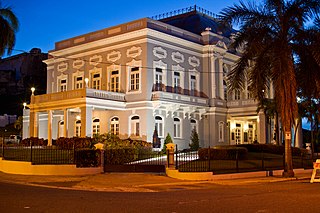
The Antiguo Casino de Puerto Rico, located at Avenida Ponce de León 1 in San Juan, Puerto Rico, is a Beaux Arts architecture style building dating from 1917. It was listed on the National Register of Historic Places in 1977, and on the Puerto Rico Register of Historic Sites and Zones in 2000.

The Gautier Benitez High School, a school named after Puerto Rican poet José Gautier Benítez, was built in 1924 in Caguas, Puerto Rico and is listed on both the U.S. National Register of Historic Places and the Puerto Rico Register of Historic Sites and Zones.

Hacienda San Francisco, also known as Hacienda Quilichini, is a sugar mill complex with hacienda house that was listed on the U.S. National Register of Historic Places in 1995 and on the Puerto Rico Register of Historic Sites and Zones in 2000. The sugar mill was built in 1871. The hacienda house and a mill are regarded as contributing buildings; there are also a kitchen, a shed, a water tower, and some other buildings.

The Church of San Fernando de La Carolina, also known as the San Fernando Rey Parish Church, is a historic Catholic parish located in Carolina Pueblo, the historical and administrative center of the Puerto Rican municipality of Carolina. The church building was built between 1860 and 1862, with further modifications made in 1870 and 1984. The church was added to the United States National Register of Historic Places on September 18, 1984, and on the Puerto Rico Register of Historic Sites and Zones on February 3, 2000.

The San Pedro Mártir Parish Church of Guaynabo is a historic parish church of the Roman Catholic Archdiocese of San Juan de Puerto Rico, located in Guaynabo Pueblo in the Puerto Rican municipality of the same name. The church was added to the United States National Register of Historic Places on September 8, 1976, and to the Puerto Rico Register of Historic Sites and Zones in 2000.

The Church of Nuestra Señora de la Concepción y San Fernando of Toa Alta, better known as the Church of San Fernando of Toa Alta, is a historic Roman Catholic parish church located in the main town square of Toa Alta Pueblo, the administrative and historic center of the municipality of Toa Alta, Puerto Rico.
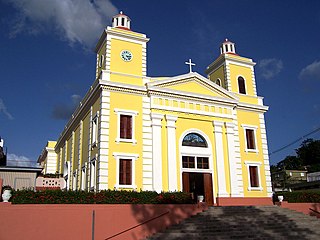
The Church of Saint Michael the Archangel of Utuado is a historic Roman Catholic parish church located in Utuado Pueblo, the administrative and historic center of the municipality of Utuado, Puerto Rico. The church is listed in the Inventory of the Historic Churches of Puerto Rico, the Puerto Rico Register of Historic Sites and Zones and the United States National Register of Historic Places due to its architectural and historical significance.
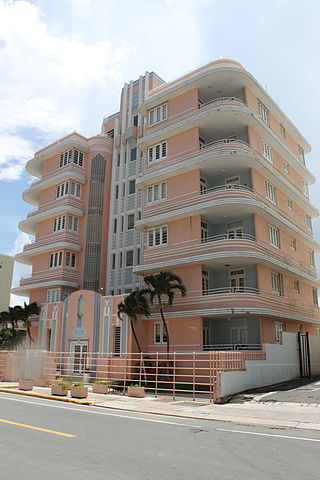
The Miami Building, also known as the Miami Apartments or the 868 Ashford Building, is a historic Art Deco building located in the Avenida Ashford of the Condado section of Santurce in the city of San Juan, Puerto Rico. The building was added to the National Register of Historic Places in 1984 and to the Puerto Rico Register of Historic Sites and Zones in 1995.




















